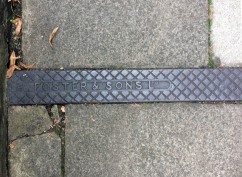29th September 2024
Gulley grates and gutters in Bishophill
John Pearson writes about an intriguing subject under our feet locally
Bishophill lies to the south of the centre of York, bounded by the River Ouse and the City Walls. It’s an important historical area, playing a crucial role from as far back as Roman times. But one of its perhaps lesser known features is a fine collection of Victorian ironware associated with rainwater disposal.
These are the gutters, gulleys and drains in the street, that divert flows of surface water into the River Ouse. Iron castings, some up to 150 years old, are readily visible in this low-traffic residential area, often framed at the roadside by the black stone setts that formerly covered all the street.
Bishophill streetware was mostly supplied by a small group of local iron founders, based in the city centre, close to the River Foss. River transport was important for material supplies: pig iron from Teesside, coal from the West Riding and sand, essential in the moulding process.
The casting process takes place in special mould boxes, containing hard-packed sand of known consistency and controlled moisture content. The impression of the object to be moulded is created within two halves of the mould box, by a three-dimensional ‘pattern’. When this is removed, the two halves are bolted together, forming a void, connected to the upper surface by two or more holes. Molten iron from a crucible is poured into one of the holes, until it fills the void and appears in the other vent(s). The iron is left to cool, after which the mould box is opened, sand removed, and the casting trimmed, cleaned and finished.
In low-wage Victorian York it was an efficient and skilled process, turning out municipal ironware at a few shillings per item. However it was laborious, generating unhealthy heat, steam and dust that injured lungs in the days before safety legislation. It also created a strong thirst for beer from the many inns and taverns in Fossgate and Walmgate.
The foundries

George Kirk was originally based in Layerthorpe, followed by a move across the Foss to Peasholme Green in 1889. General commercial casting in brass and iron, and municipal ironware.
Kirk gulley grate from Kyme Street
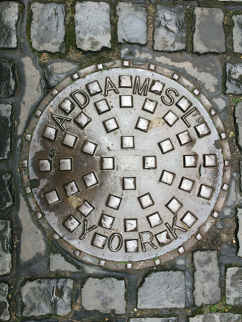 Samuel Adams of Heworth Green, moved to Peasholme Green, beside the Foss in 1895. Specialised in sewage treatment and disposal, both domestic and municipal. The Adams Works was close to that of Kirk. The two firms merged in 1919.
Samuel Adams of Heworth Green, moved to Peasholme Green, beside the Foss in 1895. Specialised in sewage treatment and disposal, both domestic and municipal. The Adams Works was close to that of Kirk. The two firms merged in 1919.
Adams manhole cover, Barker Lane

Richard Bagnall, pavement drain, Baile Hill Terrace
Dixon’s Yard, Walmgate was originally occupied by John Walker, who built a substantial house on site. It was famous for estate ironware - railings and gates - with important commissions throughout the North and Home Counties, even exporting to the Empire. Also municipal ironware, expanding to domestic hardware. Later Walker moved to new premises in Walmgate (see below). Foundry then taken over by three generations of the Bagnall family in 1856.
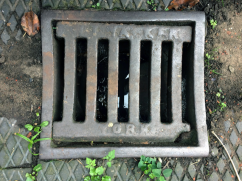 WT Walker, hinged gully grate, Newton Terrace back alley
WT Walker, hinged gully grate, Newton Terrace back alley
Victoria Ironworks, Walmgate. Close to Dixon’s Yard, at a time when William Walker had taken on the business following his father’s death. He expanded the range of domestic and commercial hardware, including innovations in central heating and security. Public showrooms fronting on Walmgate displayed prominently the Royal Warrant, granted for supplying railings and gates for the Royal Botanic Gardens, Kew.
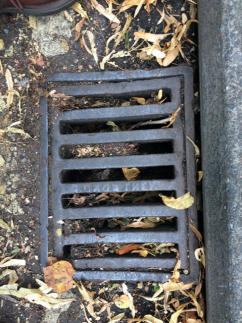 City Foundry, Hungate. Used by George Crowther between 1876 and 1889, then Richard Bagnall, after 1895. Municipal and general commercial ironware.
City Foundry, Hungate. Used by George Crowther between 1876 and 1889, then Richard Bagnall, after 1895. Municipal and general commercial ironware.
G Crowther, gulley grate, Dewsbury Terrace
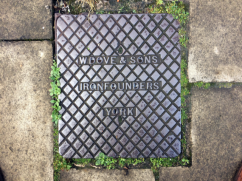 W Dove, drain cover, Fairfax Street
W Dove, drain cover, Fairfax Street
William Dove, Lady Peckett’s Yard. Produced municipal ironware, plus domestic ironmongery for their retail premises at the corner of Pavement/Parliament Street. Supplied decorative ironware for the re-opening of Lendal Bridge in 1910.
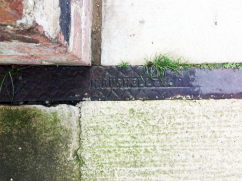 Herbert Bushell, originally Tanner Row, moving to Piccadilly by 1895. Municipal streetware; general commercial output.
Herbert Bushell, originally Tanner Row, moving to Piccadilly by 1895. Municipal streetware; general commercial output.
H Bushell & Sons, pavement drain, Victor Street
H Foster & Sons, pavement drain in Newton Terrace
The Phoenix Foundry, Browney Dyke, overlooking the Foss Basin. H Foster produced municipal streetware.
So next time you're taking a stroll around Bishophill, or possibly visiting the Golden Ball, take a look at the history under your feet!
Sources
Much information came from the extensive range of trade directories held in York Explore, York City Library. The papers of the Adams family are held in the Borthwick Institute for Archives at the University of York, while information on the Walker business largely comes from an article by John Malden in the first issue of the York Historian, 1976. Other information came from personal contact with the Kirk and Bagnall families and from issues of the Yorkshire Evening Press and Yorkshire Gazette and Herald.
This blogpost represents a summary of information contained in Gulley Grates and Gutters: Victorian Streetware in Bishophill, York, a booklet published in 2021 by R.W. Kirk and J.O. Pearson, which is available as a hard copy at the York Explore Library and Archive. Although now out of print, a pdf of the booklet is available, free of charge, from pearsonjohn217@gmail.com


